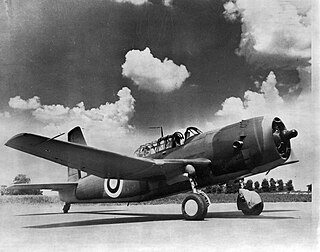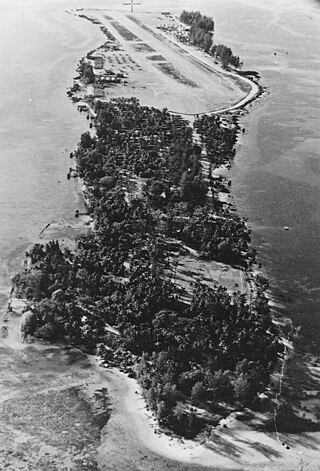
Royal Air Force Kai Tak or more commonly RAF Kai Tak is a former Royal Air Force station situated in Hong Kong, at Kai Tak Airport, Kowloon. It was established by the Royal Air Force (RAF) in 1927 and used for seaplanes. The RAF flight operated a few land based aircraft as well as having spare aircraft for naval units.

The Sembawang Air Base is a military airbase of the Republic of Singapore Air Force (RSAF) located at Sembawang, in the northern part of Singapore. The base motto is Swift and Resolute.

The Mobile Naval Airfield Organisation (MNAO) was the shore-based component of the naval air logistics organisation. This comprised two types of units, a Mobile Operational Naval Air Base (MONAB) and a Transportable Aircraft Maintenance Yard (TAMY). These were mobile units, the first of which formed in 1944, to provide logistical support to the Fleet Air Arm squadrons of the Royal Navy's British Pacific Fleet, towards the end of World War II.
HMS Nabbington, was a Royal Navy (RN), Mobile Operational Naval Air Base (MONAB), that was established at the Royal Australian Air Force (RAAF) base RAAF Nowra at Nowra, New South Wales, in Australia during the final stages of the Second World War. HMS Nabbington was also known as MONAB I and Royal Naval Air Station Nowra.
HMS Nabthorpe was a Royal Navy, (RN), Mobile Operational Naval Air Base (MONAB) situated at the Royal Australian Air Force (RAAF) base RAAF Station Schofields located at Schofields, New South Wales during the final year of the Second World War. HMS Nabthorpe was also known as MONAB III and Royal Naval Air Station Schofields.

1701 Naval Air Squadron was a Naval Air Squadron of the Royal Navy's Fleet Air Arm (FAA). It was formed in February 1945 at HMS Daedalus, RNAS Lee-on-Solent, as an amphibian bomber reconnaissance squadron. It was equipped with Supermarine Sea Otter, and the squadron joined HMS Begum in April 1945 bound for the Far East. The squadron was intended to join the newly established Mobile Naval Air Bases for Air Sea Rescue duties. 'B' Flight joined MONAB IV at RNAS Ponam in the Admiralty Islands in May 1945 and embarked in HMS Reaper in October 1945. 'A' Flight joined MONAB VI at RNAS Maryborough, Queensland, Australia in June 1945. The flights re-grouped in the Autumn of 1945 at HMS Nabcatcher, RNAS Kai Tak, Hong Kong, where it disbanded during August 1946.

778 Naval Air Squadron was a Naval Air Squadron of the Royal Navy's Fleet Air Arm. During the Second World War the squadron was a Service Trials Unit (STU) initially based at HMS Daedalus, RNAS Lee-on-Solent, Hampshire, England before moving to HMS Condor, RNAS Arbroath, Angus, Scotland on 6 July 1940. The squadron tested all types of aircraft that could be used by the Royal Navy. Key to this was testing new types for deck landing on aircraft carriers. Such aircraft included various types of Supermarine Seafires, Grumman Hellcats, Grumman Martlets, Grumman Avengers, and Vought Corsairs. The squadron was reformed on 5 November 1951 with Douglas Skyraider AEW.1 but was disbanded on 7 July 1952 to form the basis of 849 Naval Air Squadron.

706 Naval Air Squadron was a Naval Air Squadron of the Royal Navy's Fleet Air Arm. Established as a fighter and torpedo-bomber training unit in Australia at the end of World War Two, it was briefly reformed as a helicopter squadron in the early 1950s, before becoming a helicopter training unit in 1962, and operating until 1998.

721 Naval Air Squadron was a Naval Air Squadron of the Royal Navy's Fleet Air Arm (FAA). 721 Naval Air Squadron formed at HMS Gadwall, RNAS Belfast, Northern Ireland, at the beginning of March 1945, as a Fleet Requirements Unit for the British Pacific Fleet. Initially equipped with Vultee Vengeance target tugs, it arrived at HMS Nabaron, RNAS Ponam, Admiralty Islands in May 1945, and commenced operations towing targets. The squadron moved to HMS Nabsford, RNAMY Archerfield, Brisbane, Australia, during October and then relocated to Hong Kong at the beginning of 1946, moving to HMS Nabcatcher, RNAS Kai Tak, where it eventually disbanded at the end of 1947.

757 Naval Air Squadron was a Naval Air Squadron of the Royal Navy's Fleet Air Arm. It was first formed as a Telegraphist Air Gunner Training Squadron in 1939, operating out of RNAS Worthy Down, but after three months it went into abeyance, only to reform again in the same role, at the same location, in 1941 and operating until 1942. It then reformed as a Fighter Pool Squadron & Operational Training Unit at RNAS Puttalam, in Sri Lanka, in 1943. After a brief spell at RNAMY Tambaram, in India, the squadron finally disbanded at RNAS Katukurunda, in Sri Lanka, at the beginning of 1946.

777 Naval Air Squadron was a Naval Air Squadron of the Royal Navy's Fleet Air Arm, which formed as a Fleet Requirements Unit in West Africa during the Second World War. Throughout most of 1943, the squadron was responsible for the air defence of Sierra Leone. It disbanded at HMS Spurwing, RNAS Hastings, Sierra Leone, during December 1944. The squadron reformed in May 1945, from 'B' Flight of 778 Naval Air Squadron, as a Carrier Trials Unit operating aboard HMS Pretoria Castle, and using shore bases at HMS Siskin, RNAS Gosport, and HMS Peregrine, RNAS Ford in England, and HMS Wagtail, RNAS Ayr, in Scotland. 777 Naval Air Squadron number was assigned to the aircraft collection at the Fleet Air Arm Museum in April 2006.

791 Naval Air Squadron was a Naval Air Squadron of the Royal Navy's Fleet Air Arm which last disbanded at Sembawang in June 1947. It formed as an Air Target Towing Unit, at HMS Condor, RNAS Arbroath, in Scotland, in October 1940. It operated various types of aircraft for target towing duties, used to support air gunnery training and practice. The squadron disbanded in December 1944, at Arbroath. It reformed at RNAS Trincomalee, in British Ceylon,, in November 1945, as a Fleet Requirements Unit. The squadron moved to RNAS Sembawang, in Singapore, in December 1945, ferried via the escort carrier, HMS Smiter. It also operated a Communications Flight and an Air-Sea Rescue Flight, as well as undertaking anti Mosquito spraying duties.

794 Naval Air Squadron was a Naval Air Squadron of the Royal Navy's Fleet Air Arm which disbanded in March 1947. The squadron formed as an Air Target Towing Squadron, at HMS Heron, RNAS Yeovilton, during August 1940, although operated target tug aircraft out of the satellite, RNAS Haldon. In April 1943 it provided a detachment at RAF Warmwell as an air firing unit and three months later the squadron relocated to RNAS Angle and became the Naval Air Firing Unit. Further moves followed in quick succession, to HMS Goldcrest, RNAS Dale, in September, HMS Dipper, RNAS Henstridge, in November and HMS Heron II, RNAS Charlton Horethorne in December and by which time the squadron was designated No. 1 Naval Air Firing Unit, but disbanded in June 1944. The squadron reformed at HMS Vulture, RNAS St Merryn, in January 1945, as the School of Air Firing and later in the year was tasked to support the newly formed Ground Attack School. It moved to HMS Gannet, RNAS Eglinton, during August, and at this point had three flights providing courses for aerial warfare, airstrike and aerial reconnaissance.

1853 Naval Air Squadron was a Naval Air Squadron of the Royal Navy's Fleet Air Arm. It formed at RN Air Section Brunswick, in the United States on 1 April 1945 as a fighter squadron, with eighteen Vought Corsair Mk IV fighter aircraft. Following deck landing training aboard USS Charger, it embarked in HMS Rajah for the United Kingdom on 24 July. It disembarked to HMS Landrail, RNAS Machrihanish, on 6 August, but due to V-J Day it disbanded there on 15 August.
1843 Naval Air Squadron was a Naval Air Squadron of the Royal Navy's Fleet Air Arm between 1943 and 1945 and then a Royal Naval Volunteer Reserve Air Squadron from 1953 to 1957. It formed in the United States at RN Air Section Brunswick, in May 1944, as a fighter squadron. It arrived in the UK aboard HMS Trouncer in August. Based at HMS Gannet, RNAS Eglinton, Northern Ireland and training at HMS Wagtail, RNAS Ayr, Scotland, the squadron had deck landing training aboard HMS Patroller in December, before joining HMS Arbiter in February 1945, as part of the 10th Naval Fighter Wing. Sailing to Australia, the squadron became part of the 3rd Carrier Air Group, but saw no action before the war ended and disbanded in October 1945. It reformed as a Royal Naval Volunteer Reserve Air Branch anti-submarine squadron, in the Scottish Air Division, from 1953 and disbanded in 1957.

1845 Naval Air Squadron was a Naval Air Squadron of the Royal Navy's Fleet Air Arm. It formed at RN Air Section Brunswick, United States, in June 1944 as a fighter squadron, with eighteen Vought Corsair Mk III fighter aircraft. It embarked in HMS Puncher on 30 August, disembarking to HMS Gannet, RNAS Eglinton, Northern Ireland, on 18 September and joining the 10th Naval Fighter Wing. It re-equipped with twenty-four Vought Corsair Mk IV, and embarked HMS Slinger in December, sailing for the British Pacific Fleet, the squadron was disbanded in April 1945, and its aircraft and personnel absorbed into squadrons aboard the aircraft carriers HMS Formidable and HMS Victorious. On 1 June it reformed in Australia as a single seater fighter squadron at HMS Nabsford, RNAMY Archerfield, Queensland, and it shortly later became a spare squadron in the 3rd Carrier Air Group at HMS Nabbington, RNAS Nowra, New South Wales. With the end of the Second World War the squadron disbanded on 24 October.

HMS Nabaron was a Royal Navy (RN) Mobile Operational Naval Air Base (MONAB) which was situated at the United States Navy (USN) airfield NAS Ponam Airfield on Ponam Island, Admiralty Islands in Papua New Guinea, which had been transferred to RN on loan. HMS Nabaron was also known as MONAB IV and Royal Naval Air Station Ponam.
HMS Nabswick was a Royal Navy (RN), Mobile Operational Naval Air Base (MONAB) which was initially at the Royal Australian Air Force (RAAF) satellite airfield Jervis Bay Airfield situated near Jervis Bay Village, Jervis Bay Territory. HMS Nabswick was also known as MONAB V and Royal Naval Air Station Jervis Bay.
HMS Nabsford was a Royal Navy (RN), Transportable Aircraft Maintenance Yard (TAMY), which was situated at the Royal Australian Air Force (RAAF) airfield RAAF Station Archerfield situated in Brisbane, Queensland. HMS Nabsford was also known as TAMY I and Royal Naval Aircraft Maintenance Yard Archerfield.
HMS Nabstock was a Royal Navy (RN), Mobile Operational Naval Air Base (MONAB) which was initially located at the Royal Australian Air Force (RAAF) airfield RAAF Maryborough situated in Maryborough, Queensland. HMS Nabstock was also known as MONAB VI and Royal Naval Air Station Maryborough, between June and November 1945. It decommissioned and moved to RAAF Station Schofields located at Schofields, New South Wales, where MONAB VI recommissioned as HMS Nabstock and known here as Royal Naval Air Station Schofields until June 1946.














